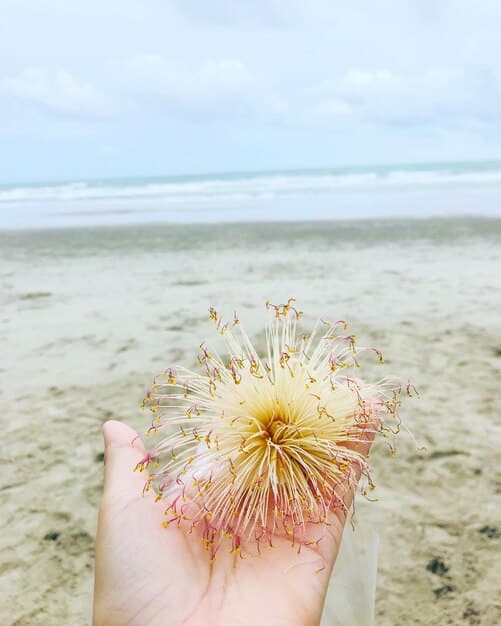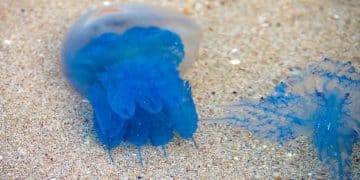Avoid Jellyfish Stings: New Research & Safe Swimming Tips

Avoid jellyfish stings by learning about new research on protective gear and safe swimming practices, ensuring a safer and more enjoyable beach experience.
Summer days at the beach are a quintessential American pastime. However, the joy of swimming in the ocean can quickly turn sour with an unexpected encounter with a jellyfish. The good news is that new research is constantly emerging to help us avoid jellyfish stings. This article will delve into the latest findings on protective gear and safe swimming practices, so you can have a worry-free beach experience.
Understanding the Jellyfish Sting Problem
Jellyfish stings can range from mildly irritating to severely painful, and in rare cases, even life-threatening. Understanding the risks and types of jellyfish present in your swimming area is the first step in preventing these stings. Let’s take a closer look at what makes jellyfish stings so problematic.
Why Jellyfish Sting
Jellyfish sting as a defense mechanism and to capture their prey. Their tentacles are equipped with nematocysts, tiny, venom-filled barbs that inject venom into anything they encounter. This venom can cause a variety of reactions in humans, leading to pain, inflammation, and other symptoms.
- Different jellyfish species have different types and potencies of venom.
- The severity of a sting depends on the species of jellyfish, the amount of contact, and the individual’s sensitivity.
- Some people may experience allergic reactions to jellyfish venom, requiring immediate medical attention.
Common Jellyfish Species in US Waters
Several jellyfish species are commonly found in US waters, and it’s essential to be aware of their presence and potential risks. Knowing which jellyfish are prevalent in your area can help you take appropriate precautions.
Here are some of the most common culprits:
- Moon Jellyfish: Generally harmless, with mild stings.
- Lion’s Mane Jellyfish: Found in cooler waters; their stings can be painful.
- Sea Nettle: Common along the Atlantic coast, known for their itchy and burning stings.
- Portuguese Man-of-War: Technically a siphonophore, not a jellyfish, but its stings can be extremely painful and dangerous.
Being aware of these jellyfish species and their potential dangers is crucial for safe swimming. Local beach authorities often provide information about recent jellyfish sightings and warnings.
Understanding the basics of jellyfish stings and identifying common species will help you take proactive steps towards ensuring a safer beach experience, allowing you to enjoy the water with peace of mind.
The Latest on Protective Gear for Swimmers
One of the most effective ways to avoid jellyfish stings is by using protective gear. Recent advancements in material technology have led to the development of more efficient and comfortable options. These materials not only protect against stings but also offer UV protection, making them ideal for long days at the beach.

Stinger Suits: A Barrier Against Stings
Stinger suits are full-body coverings designed to protect swimmers from jellyfish stings. Made from lightweight, flexible materials, these suits provide a physical barrier that prevents jellyfish tentacles from contacting the skin. Modern stinger suits offer improved comfort and mobility, making them a practical option for water sports enthusiasts.
- Stinger suits are made from materials like Lycra or Spandex, providing a snug yet comfortable fit.
- They cover the entire body, including arms and legs, leaving only the face, hands, and feet exposed.
- Some stinger suits come with hoods and gloves for additional protection.
Advances in Fabric Technology
Recent breakthroughs in textile technology have made stinger suits more effective and comfortable. Researchers have focused on developing materials that are both sting-proof and breathable, ensuring optimal comfort during prolonged use.
New fabric technologies include:
- High-Density Weaves: Tightly woven fabrics that prevent nematocysts from penetrating.
- Microfiber Materials: Lightweight and quick-drying, enhancing comfort and mobility.
- UV Protection: Many protective garments now offer UPF 50+ protection, shielding against harmful sun rays.
Choosing the Right Protective Gear
Selecting the right protective gear depends on the type of water activity and the prevalence of jellyfish in the area. Consider the following factors when choosing your gear:
When shopping for protective gear, keep these tips in mind:
- Coverage: Ensure the gear covers as much of your body as possible for maximum protection.
- Fit: Choose a snug fit to minimize water entry and maintain mobility.
- Material: Opt for high-quality, sting-proof, and breathable materials.
Investing in quality protective gear ensures a safer and more enjoyable swimming experience, allowing you to explore the ocean without the fear of jellyfish stings.
Safe Swimming Practices to Minimize Sting Risk
Even with the best protective gear, adopting safe swimming practices can significantly reduce the risk of jellyfish stings. Staying informed, being cautious, and knowing how to react in case of a sting are all essential components of a safe beach experience.
Staying Informed About Local Conditions
Before heading to the beach, check local weather and water conditions. Many beaches provide alerts for jellyfish sightings and other marine hazards. This information can help you make informed decisions about when and where to swim.
Staying updated is key:
- Check local beach websites and social media pages for recent jellyfish sightings.
- Pay attention to posted warning signs and flags at the beach.
- Ask lifeguards about current conditions and potential hazards.
Avoiding Peak Jellyfish Seasons and Areas
Jellyfish populations tend to fluctuate seasonally. Learn when jellyfish are most prevalent in your area and avoid swimming during these times. Also, certain areas are more prone to jellyfish blooms than others.
Strategies for minimizing risk include:
- Swimming during off-peak seasons when jellyfish numbers are lower.
- Avoiding areas known for jellyfish concentrations, such as inlets and bays.
- Staying away from areas where jellyfish have washed ashore, as they can still sting.
Recognizing and Responding to Jellyfish Stings
Despite taking precautions, jellyfish stings can still happen. Knowing how to recognize and respond to a sting can minimize discomfort and prevent complications. The initial response is critical to reducing the severity of the sting.

Immediate first aid steps:
- Rinse the affected area with vinegar for at least 30 seconds. Vinegar helps neutralize the nematocysts in many common jellyfish species.
- Carefully remove any visible tentacles with tweezers or a gloved hand. Avoid rubbing the area, as this can cause more nematocysts to release venom.
- Apply a cold pack or ice wrapped in a cloth to reduce pain and swelling.
- Avoid rinsing with fresh water, as it can trigger more nematocysts to fire.
By staying informed, being cautious, and knowing how to respond to stings, you can significantly reduce the risk of jellyfish encounters and ensure a safer, more enjoyable beach experience.
New Research on Jellyfish Sting Treatment
While prevention is key, knowing the latest in jellyfish sting treatment is also crucial. Recent research has challenged some long-held beliefs about the best ways to treat stings, offering new insights into effective remedies and debunking common myths.
Debunking Common Myths About Jellyfish Sting Treatment
Many traditional remedies for jellyfish stings have been proven ineffective or even harmful. It’s important to separate fact from fiction when it comes to treating these stings. Let’s debunk some common myths:
Here are some myths and facts:
- Myth: Urinating on a jellyfish sting provides relief. Fact: Urine is not an effective treatment and can sometimes worsen the sting due to its varying pH levels.
- Myth: Rubbing the sting area with sand helps remove tentacles. Fact: Rubbing can cause more nematocysts to release venom, exacerbating the pain.
- Myth: Applying heat is always beneficial. Fact: Heat can be helpful in some cases, but it’s not a universal remedy and may worsen the sting from certain species.
The Role of Vinegar in Jellyfish Sting Treatment
Vinegar is widely recommended as an initial treatment for jellyfish stings, as it can help neutralize the nematocysts in many species. However, it’s not a one-size-fits-all solution. Always follow local guidelines and advice from lifeguards, as the best treatment can vary depending on the jellyfish species.
Recommendations for using vinegar effectively:
- Use household vinegar (5% acetic acid) for rinsing the affected area.
- Apply vinegar for at least 30 seconds to ensure thorough neutralization of nematocysts.
- Avoid using vinegar on stings from the Portuguese Man-of-War, as it can worsen the pain.
Advanced Medical Treatments for Severe Stings
In some cases, jellyfish stings can cause severe reactions that require advanced medical treatment. These treatments are aimed at managing pain, reducing inflammation, and addressing any systemic symptoms. Seek immediate medical attention if you experience severe symptoms such as difficulty breathing, chest pain, or muscle cramps.
Advanced treatments may include:
- Antivenom: Available for certain jellyfish species, antivenom can neutralize the venom and alleviate symptoms.
- Pain Management: Medications such as antihistamines, corticosteroids, and analgesics can help manage pain and inflammation.
- Supportive Care: In severe cases, supportive care such as oxygen therapy, IV fluids, and monitoring of vital signs may be necessary.
Staying informed about the latest research and best practices ensures that you’re prepared to handle jellyfish stings effectively, minimizing discomfort and preventing serious complications.
Protective Behaviors Before Stinging Occurs
Beyond gear and immediate responses, adopting protective behaviors can significantly reduce your risk of jellyfish encounters. These behaviors involve understanding jellyfish habits, being mindful of your surroundings, and using simple strategies to avoid contact.
Understanding Jellyfish Behavior
Jellyfish behavior is influenced by weather, water conditions, and time of day. Understanding these patterns can help you make informed decisions about when and where to swim.
Factors influencing jellyfish behavior:
- Weather Conditions: Jellyfish tend to be more prevalent after storms, when they are carried closer to shore by currents.
- Water Temperature: Warmer water temperatures can promote jellyfish blooms.
- Time of Day: Some jellyfish species are more active during certain times of the day, such as early morning or late afternoon.
Strategic Swimming Practices
Where and how you swim can also impact your risk of encountering jellyfish. Strategic swimming practices involve being aware of your surroundings and avoiding areas where jellyfish are likely to be present.
Practices to minimize risk:
- Swim in Designated Areas: These areas are often monitored by lifeguards and may be less prone to jellyfish.
- Avoid Cloudy Water: Jellyfish can be harder to spot in murky or cloudy water.
- Shuffle Your Feet: When wading in shallow water, shuffle your feet to alert jellyfish to your presence and potentially avoid stings.
Educating Children and Other Swimmers
Education is key to preventing jellyfish stings. Teach children and other swimmers about the risks of jellyfish stings and the importance of following safe swimming practices. Explain how to identify jellyfish and what to do if they encounter one.
Education tips:
- Inform children about the appearance of common jellyfish species in your area.
- Teach them to avoid touching or picking up jellyfish, even if they appear dead.
- Emphasize the importance of reporting jellyfish sightings to lifeguards or beach authorities.
By adopting these protective behaviors, you can significantly reduce your risk of jellyfish encounters and create a safer swimming environment for yourself and others.
Future Directions in Jellyfish Sting Prevention
The quest to avoid jellyfish stings is ongoing, with researchers continually exploring new methods of prevention and treatment. Innovations in protective gear, venom research, and public awareness campaigns promise to further reduce the risk of jellyfish encounters in the future.
Innovations in Protective Gear Materials
Scientists are exploring new materials that offer even greater protection against jellyfish stings. These materials are designed to be lighter, more comfortable, and more effective at preventing nematocysts from penetrating the skin.
Emerging material technologies:
- Nanotechnology Fabrics: Fabrics with microscopic pores that prevent nematocysts from passing through.
- Biomimicry: Materials inspired by the natural defenses of marine animals that are resistant to jellyfish stings.
- Self-Healing Materials: Fabrics that can repair minor damage, ensuring long-lasting protection.
Venom Research and Antivenom Development
Understanding the composition and effects of jellyfish venom is crucial for developing effective treatments. Researchers are working to isolate and neutralize the active components of venom, leading to the development of new antivenoms and therapies.
Advances in venom research:
- Venomics: Comprehensive analysis of venom composition to identify key toxins.
- Antivenom Development: Creation of species-specific antivenoms for the most dangerous jellyfish stings.
- Drug Discovery: Identification of compounds that can block the effects of jellyfish venom.
Public Awareness and Education Campaigns
Efforts to raise public awareness about jellyfish sting prevention are essential for reducing the number of incidents. Education campaigns can provide swimmers with the knowledge and tools they need to stay safe in the water.
Strategies for enhancing public awareness:
- Informative Websites and Apps: Providing real-time information about jellyfish sightings and safe swimming practices.
- Beach Safety Programs: Offering educational programs at beaches to teach swimmers about jellyfish risks and prevention methods.
- Community Outreach: Collaborating with local organizations and schools to promote jellyfish sting awareness.
By continuing to invest in research, innovation, and public education, we can look forward to a future where jellyfish stings are less of a concern, allowing everyone to enjoy the ocean safely and confidently.
| Key Point | Brief Description |
|---|---|
| 🛡️ Protective Gear | Use stinger suits and rash guards for full-body protection. |
| ⚠️ Stay Informed | Check local alerts and conditions before swimming. |
| 🩹 First Aid | Rinse stings with vinegar and remove tentacles carefully. |
| 🔬 New Research | Advancements in fabric and venom research improve prevention. |
FAQ
▼
Common jellyfish stings range from mild irritation to severe pain, depending on the species. In US waters, sea nettle and lion’s mane jellyfish are frequent culprits, known for causing burning sensations and welts.
▼
Protective gear like stinger suits provides a physical barrier, preventing jellyfish tentacles from contacting the skin. These suits are made from materials like Lycra or Spandex, offering full-body coverage and reducing sting risk.
▼
Immediately rinse the affected area with vinegar for at least 30 seconds to neutralize the nematocysts. Carefully remove any visible tentacles with tweezers or a gloved hand, avoiding rubbing the area.
▼
Jellyfish prevalence often depends on weather, water temperature, and season. They are more common after storms and in warmer waters. Check local conditions and alerts before swimming to minimize risk.
▼
Common myths include urinating on the sting or rubbing it with sand. These methods are ineffective and may worsen the sting. Vinegar is the recommended first-aid treatment, followed by careful tentacle removal.
Conclusion
Staying informed about the latest research on protective gear and adopting safe swimming practices are vital for a worry-free beach experience. By understanding jellyfish behavior, using effective protective measures, and knowing how to treat stings, you can significantly reduce your risk and enjoy the ocean with confidence. Always prioritize safety and awareness to make the most of your time at the beach.





